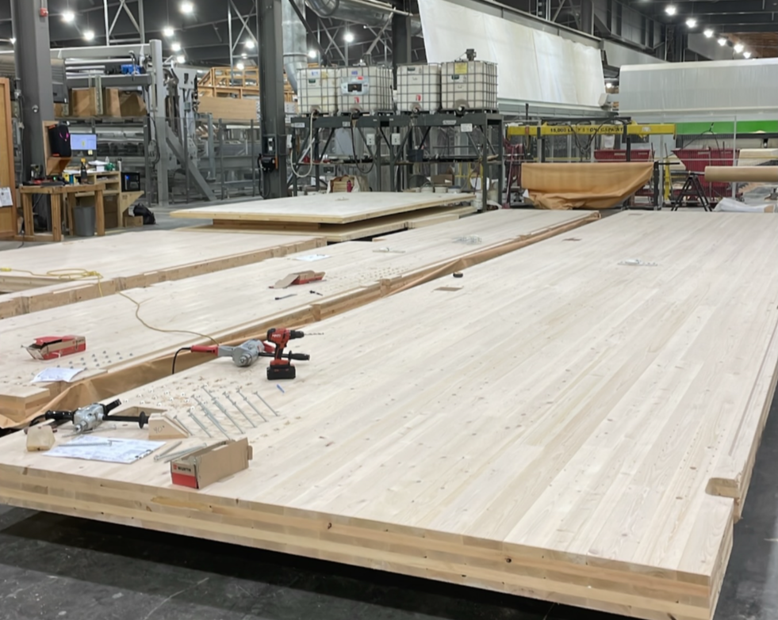The mass timber assemblies are the centerpiece of the Tall Timber Student Housing building’s design. While the installation process is straightforward and quick, the work that goes into preparing and delivering mass timber is complex. To deliver panels that are ready for quick installation on site requires a careful process of design coordination and then precise manufacturing.
This brings together a multi-disciplinary team including the building’s architects, structural, mechanical, and electrical engineers, general contractor, and local manufacturers, to meet the specifications of the building.
In the Tall Timber Student Housing Building the large panels are 3.5 meters (11.5 feet) wide because this panel size aligns the width of the bedroom suits, such that supporting columns can be hidden within the demising walls. The length of the panels spans the width of the building, which improves manufacturing and installation efficiency.
As part of the design phase each of the apertures that will take pipes, HVAC ducts, and electrical conduit are mapped out, as these will be fitted to the panels during manufacturing.
Jamie Pobre Sullivan, Associate from Fast+ Epp, who are the structural engineer on the project explains, “This coordination at the design stage is what allows the prefabricated panels to be installed so quickly on site, so we need to review everything from materials to trade coordination with trades prior to construction.”
For this project the panels make use of Western Hemlock, which was a request by the CLT manufacturer, Kalesnikoff Mass Timber, to maintain construction schedule, but is also a design innovation. It’s a local material that’s accessible to the local manufacturer, so it makes sense to use it, but because it’s new we had to have validate confidence using the species within a point-supported CLT panel system.
However, we had just finished a round of point-supported CLT punching shear tests at our Concept Lab, which validated higher punching shear values. By working with the Kalesnikoff to ensure that the project panel grades met the specifications, we were able to maintain the critical construction schedule.”

The completed CLT panel designs are manufactured to the specifications by Kalesnikoff at their mill and production facilities in Castlegar.
There the lumber is digitally scanned and graded before being cut and dried using Steam Injection Dry Kilns. Mass timber panels need a moisture content of 15% or less to be used, so the drying process can take between 40-120 hours.
The lumber is then formed into panels on an assembly line. The layers are “cooked” together to ensure proper adhesion and meet the specifications set out by the structural design team. At this stage all the carefully designed apertures for pipes, HVAC ducts and electrical conduit are pre-cut, and the reinforcing screws, where required, are also installed. In the case of the Tall Timber Student Housing Project this includes fitting more that 26,000 screws into the panels.
Once they are ready for installation the panels are loaded onto the flatbed trucks. To maximize the efficiency the panels are loaded in the order that they will be installed on the building.
Onsite the panels complete their journey. They are taken directly from the truck beds to be fitted on the structural steel columns and cores of the building. They are the first part of the prefabricated assemblies to be installed followed by the curtainwall and modular envelope.
Sandra Dimitrijevic BCIT’s Senior Project Manager for Tall Timber Student Housing continues: “The entire process of installing these assemblies for an entire floor can be done in a week. Because the installation happens so quickly it’s easy to forget the amount of work that needs to go in from the project team at the design and planning stages.
We’re excited to be using such an innovative system at Tall Timber Student Housing that makes for a more efficient and sustainable construction process.”

This is the best. As a participant in BCIT’s Mass Timber Microcredential and Associate programs it’s so good to see what we’ve learned practiced at home on campus. Well done on getting up and closed in so rapidly…